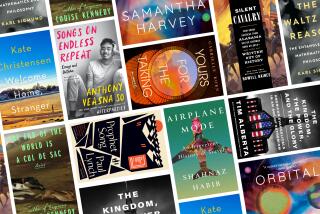Roadside attractions
- Share via
“TO the English gentleman whose name we do not recall and who in the eighteenth century walked backwards from London to Edinburgh singing Anabaptist hymns.” So goes, in part, the dedication in the last major work by Julio Cortazar, the great Argentine reality-tilter and author of “Hopscotch.”
“Autonauts of the Cosmoroute,” written in 1982 and now translated into English, is indeed something of a walk done backwards. Its text is a contemporary equivalent of the Anabaptists’ revolt against established religious good sense; here it is the religion of progress that is upended. Also note the “whose name we do not recall”: The first line of “Don Quixote” is “In a village of the Mancha whose name I do not care to recall. . . .”
The journey undertaken by Cortazar and his wife and collaborator Carol Dunlop is quixotic in the largest sense. At one level, it is an adventure stood on its absurd head. At another, it is something graver -- a mask of comedy concealing the enigma of an archaic smile. Just as the spindle-shanked Spaniard took knightly fiction for reality and ventured out to batter it (and himself) against his world, Cortazar and Dunlop set up a fiction and batter it against theirs.
Their Mancha is the 465-mile Autoroute du Sud from Paris to Marseille. Such superhighways are the very emblem of our contemporary need for speed, for streamlined purpose, for ends (get to Marseille quick) over means (fair France along the way). Their project (terrorist, if you like) is to undermine the emblem by traveling it not fast but slowly -- not in eight hours but in 32 days, or about 14 miles a day. Loading up their red Volkswagen van, the “autonauts” are off on their “cosmoroute.” (Such mock grandiloquence suggests that subverting our current concept of time is as ambitious as traveling in space.)
The rate of progress is set by the number of rest stops (aires, the French beautifully call them) between Paris and Marseille. Their rules provide for stopping at two a day, spending the night at the second. Instead of a means, the autoroute has become a series of very small ends: the aires and the time spent at each. Instead of the rest stops serving the highway, the highway serves the rest stops. They are destinations, and in their journal -- the text of the book -- the travelers treat the pleasant ones with the grave appreciation accorded a Pisa or an Arles and those that are bare sun-baked strips with the shrug given a guidebook mistake.
The daily entries include a log of stops, of times arrived and departed, of weather and parking conditions, all written with the dry portentousness of a 17th century sailing expedition. Meals are listed in full, prepared aboard the van from a refrigerator and bottled-gas stove, with occasional Lucullan breaks at the autoroute’s excellent rest-stop cafeterias.
The greatest feasts come in the wake of expeditions mounted by friends, who drive down from Paris or up from Marseille bearing lavish prepared meals and meat, fresh vegetables and fruit. (There are allusions to scurvy; cans of sauerkraut have been packed.)
The blithely terse log entries are followed by longer journal accounts, most written by Cortazar and a few by Dunlop. They relate the routines -- arriving, choosing a parking spot (shade is essential), unpacking folding chairs, water bottles and typewriters. Daily writing stints are the heart of a venture so fragile and peculiar that only words can sustain it. At first, one’s belief does flag a little but, oddly, it grows as the slow miles pass. As with whirling dervishes, the spirit descends only after effortful flailing. The spirit is elusive for a while, in this record of days so extraordinarily limited yet extraordinarily unconfined. There is whimsicality, of course -- but we are gradually captured.
There is the comedy of invented perils and a dangerously parallel Cortazarian universe. A road crew seems to be spying on them, turning up at successive stops. The workers reveal their real (real?) purpose: to chip away restroom curbs for the sake of the handicapped. The travelers explain their own project and then “sit down to type furiously, to show them that we’re writing a book about the autoroute in order that they won’t suspect what we’re really doing: writing a book about the autoroute.”
Gassy speculations bob through the air: What is in the great trucks parked beside them? Tapioca? Safety pins? A cloud shipped from a wet country to a dry one?
Bit by bit, though, the comic veil thins into a scrim, through which graver matters appear. A Spanish driver whose wife has given birth early is relieved from lonely worry -- truck cabs are universes of solitude -- by telling them of it. He “disappears into the distance, maybe thinking that now there are two people who know about the baby girl too, two strangers who shared his joy at any old stop in the world and in life.”
Life. The road project, in all its seeming oddity, is life, but Cortazar never tells us so. His grace is such that it is the reader who begins to see this. Downplaying the gestural aspects -- the ones I have been pointing out -- he insists that the trip is a way for him and his wife to be alone together in an alternate, invented world.
There are moments of passion. Making love while lights from the highway flash through the windows “was like doing it in a kaleidoscope.” Toward the end, Dunlop addresses a deeply moving lyric to him. “The freeway is me, you, us,” she writes. “We won’t leave the autoroute in Marseille, my love, or anywhere else. There’s no turning back, only a spiral.”
The trip’s conclusion is not triumph but regret. Cortazar finished writing “Autonauts” (beautifully translated by Anne McLean) after Dunlop died, which happened four months after they got back to Paris. Long ill himself (there’s a hint or two in the text), he died little more than a year later. Along with so much else, “Autonauts” is elegy performed as the lightest of dances.
More to Read
Sign up for our Book Club newsletter
Get the latest news, events and more from the Los Angeles Times Book Club, and help us get L.A. reading and talking.
You may occasionally receive promotional content from the Los Angeles Times.






